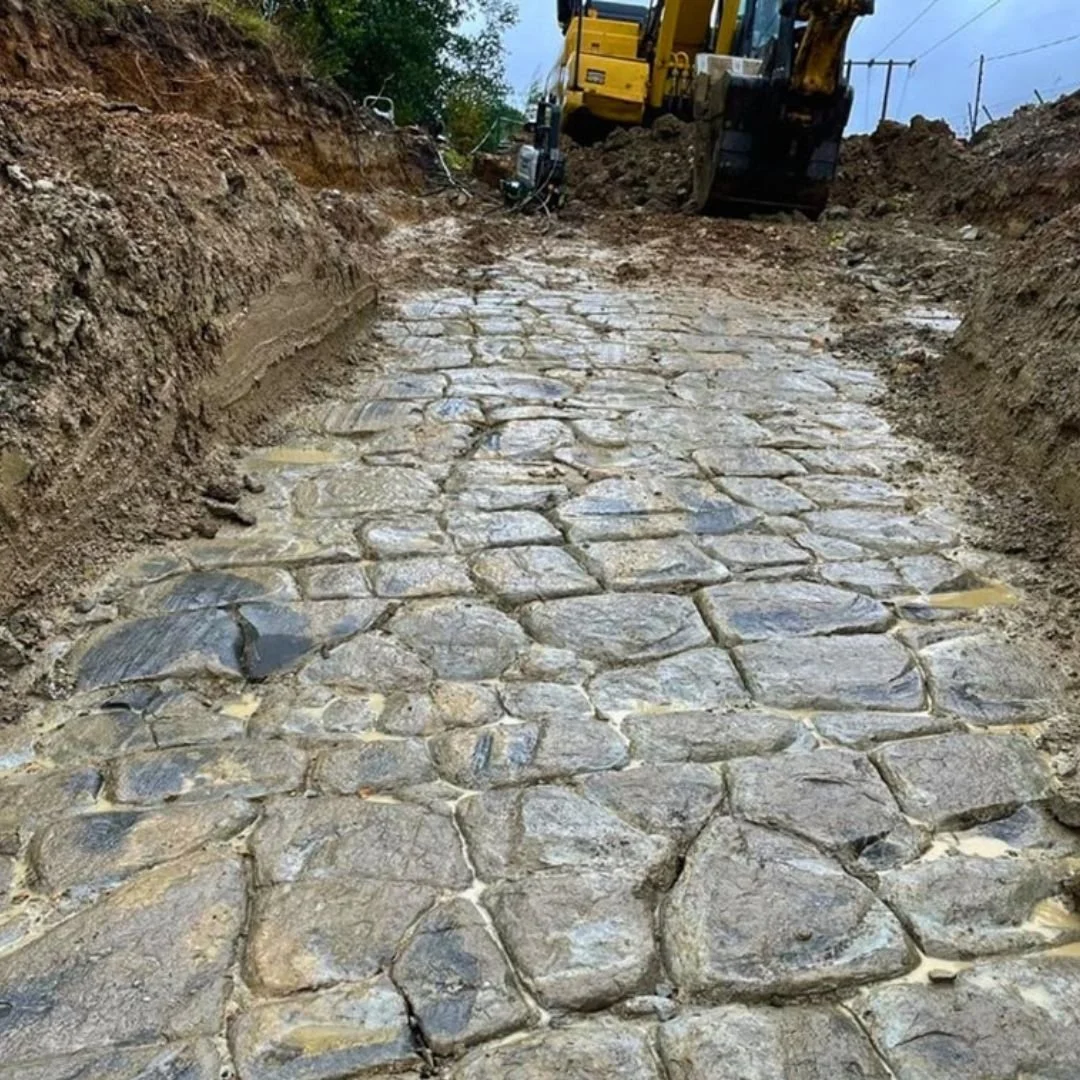2,000 Year-Old Roman Road Discovered In Worcester
Workmen uncovered a Roman road dating back 2,000 years in a field in Worcester.
The ancient road could be the only one of its kind in Britain and of ‘global importance.’
An expert has assessed it to likely be a cobbled ford, and the construction was discovered accidentally by ground workers near Evesham.
If it is in keeping with the Roman history in the area, it was built in the 1st century AD.
Experts believe that it’s the first of its kind in Britain and could be the finest example of its type in the country.
The road discovery made near Severn Trent during routine waterworks measured 10 by 2.9 meters (32 by 9 ft).
The find was uncovered on the banks of the river where a Roman-era villa and complex was uncovered just four years ago.
It is said to have been constructed like a wall with large stones laid in bands – a traditional Roman technique – with its only comparisons in Rome and Pompeii.
The exact location of the discovery is anonymous to protect it.
Excavations are taking place to find out more about the site, but experts say everything points to it being a genuine Roman structure – built 1,900 years ago.
The owners of the property contacted Wychavon District Council and a team from Historic England is now expected to analyse the excavations.
Aidan Smyth, archaeology officer from Wychavon District Council, said the discovery ‘took his breath away’.
If confirmed to originate from the first century AD, it would be ‘beyond rare’ and the only road of its type in Britain.
Mr Smyth said: ‘At the moment everything is ticking the boxes for it to be Roman but it still feels too good to be true so we are keeping an open mind.

‘If it turns out to be medieval then it is could still be considered to be nationally significant as nothing similar has been found in Britain to date.
’If it is a first-century Roman feature it is the only one of its kind to be found in Britain to date, there’s not really anything like this medieval either.
‘If it was to be a Roman feature, with its only comparisons in Rome and Pompeii, you could argue it’s of world importance, not just of national importance.
‘The stonework is absolutely perfect. It just ticks every box for being Roman.’
Wychavon District Council has confirmed as of yet, no dateable finds such as pieces of pottery or coins have been discovered which are usually used to help date the site.
The Roman army passed through the area now known as Worcestershire in the 40s and 50s AD as it pushed west to reach the River Severn on its way to Wales.
Roman roads provided efficient means for the overland movement of armies, officials, civilians, inland carriage of official communications, and trade goods.
Roman roads were of several kinds, ranging from small local roads to broad, long-distance highways built to connect cities, major towns and military bases.
These major roads were often stone-paved and metaled, cambered for drainage, and were flanked by footpaths, bridleways and drainage ditches.
They were laid along accurately surveyed courses, and some were cut through hills, or conducted over rivers and ravines on bridgework.
At the peak of Rome’s development, no fewer than 29 great military highways radiated from the capital, and the late Empire’s 113 provinces were interconnected by 372 great roads.
The whole comprised more than 250,000 miles of roads, of which over 50,000 miles were stone-paved.
The Laws of the Twelve Tables, dated to about 450 BC, required that any public road (Latin via) be 8 Roman feet (perhaps about 2.37 m) wide where straight and twice that width where curved.
These were probably the minimum widths for a via; in the later Republic, widths of around 12 Roman feet were common for public roads in rural regions, permitting the passing of two carts of standard (4 foot) width without interference to pedestrian traffic.
Romans were avid riders and rode on or drove quite a number of vehicle types.

Horse-drawn carts could travel up to 25 to 31 miles per day, compared to pedestrians which were 12 to 16 miles per day.
For purposes of description, Roman vehicles can be divided into the car, the coach, and the cart.
Cars were used to transport one or two individuals, coaches were used to transport parties, and carts to transport cargo.
Of the cars, the most popular was the carrus, a standard chariot form descending to the Romans from a greater antiquity.
The top was open, the front closed. One survives in the Vatican – it carried a driver and a passenger.
The Roman’s also created incredible, long lasting bridges – river crossings were achieved by bridges, or pontes. Single slabs went over rills.
A bridge could be of wood, stone, or both. Wooden bridges were constructed on pilings sunk into the river, or on stone piers.
Larger or more permanent bridges required arches – these larger bridges were built with stone and had the arch as its basic structure.
Most also used concrete, which the Romans were the first to use for bridges. Roman bridges were so well constructed that a number remain in use today.
If you enjoyed this blog post, please follow Exploring GB on Facebook for daily travel content and inspiration.

Don’t forget to check out our latest blog posts below!
Related Post
The entire tomb is filled with signs and symbols that mention Queen Nefertiti and after some time passed and linguistic experts managed to decipher the stories told here, the team was baffled.
The mystery of the Solar Temple of Abu Gurab and its “Star Gate” comes to light
Thuya, the mother of Queen Tiye, left a monumental legacy by becoming the grandmother of Akhenaten and Tutankhamun.
The oldest traditions lead us to believe that blacks were the first inhabitants of Mexico.
The REAL face of King Tut: The pharaoh had feminine hips, clubfoot, and protruding teeth according to the ‘virtual autopsy,’ which also revealed that his parents were brother and sister.
The “oldest gold of humanity” was found in the Varna necropolis, on the Bulgarian Black Sea coast





